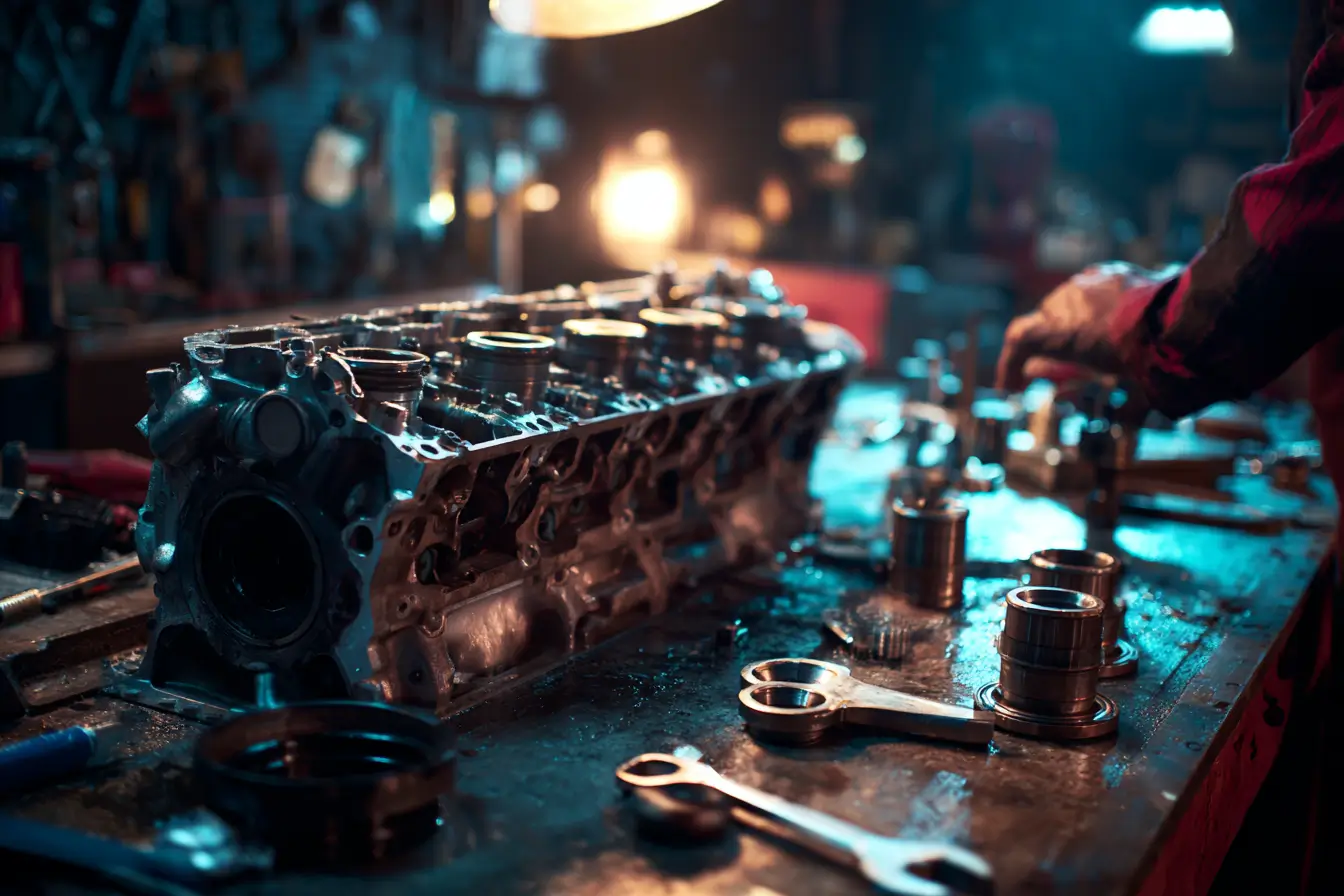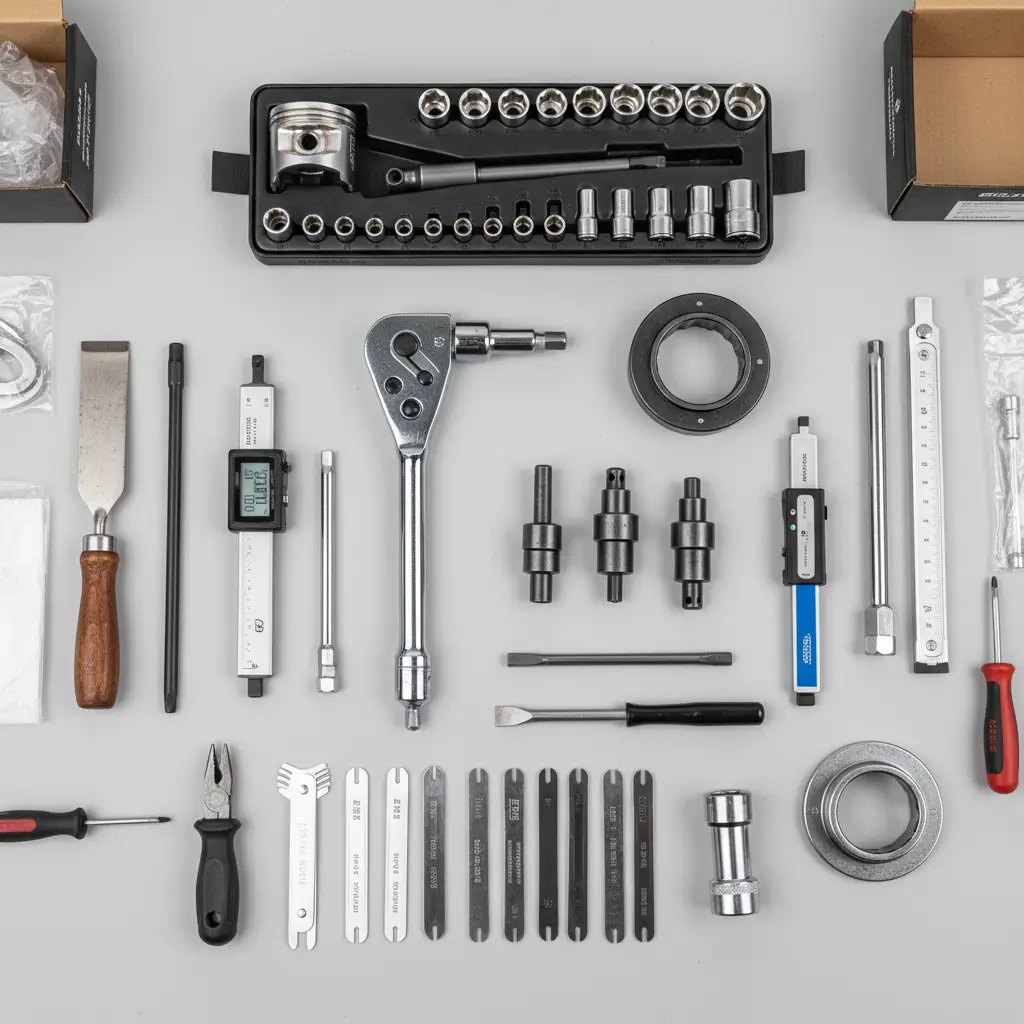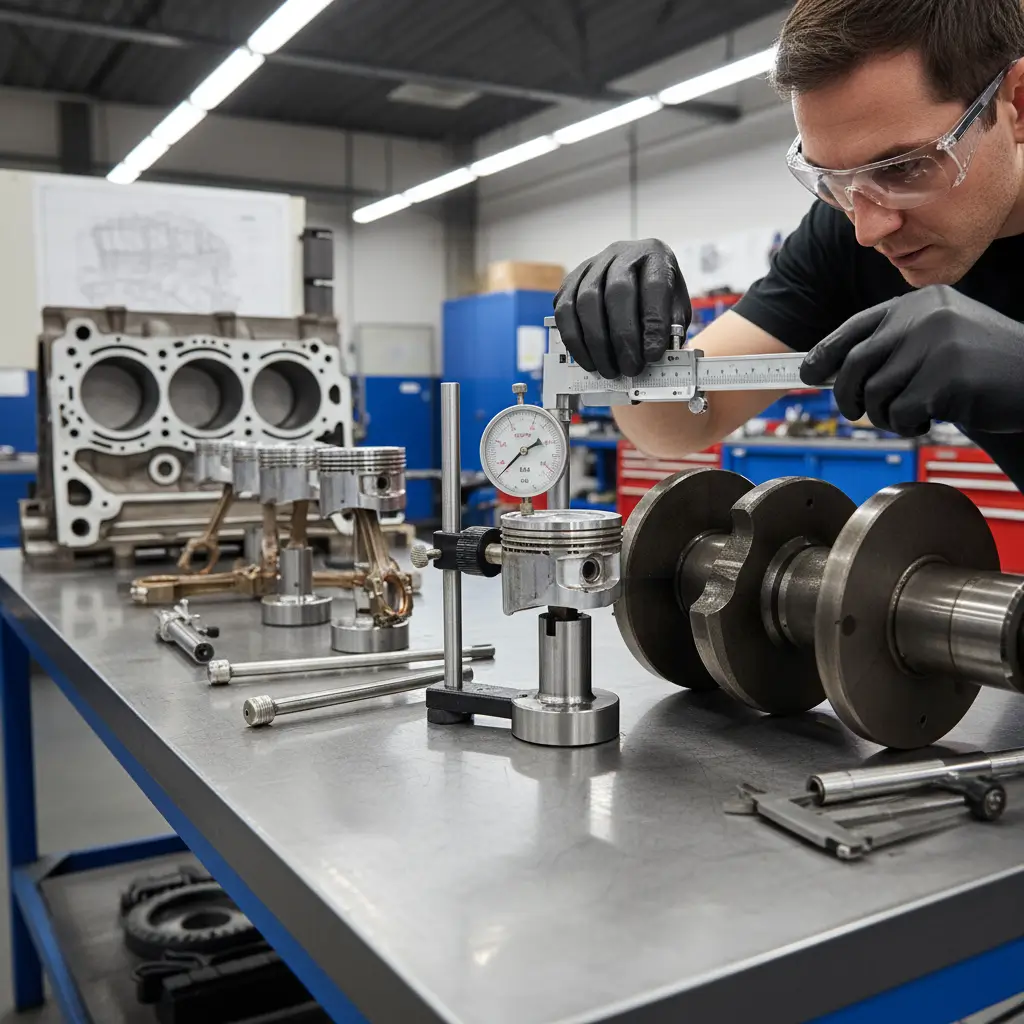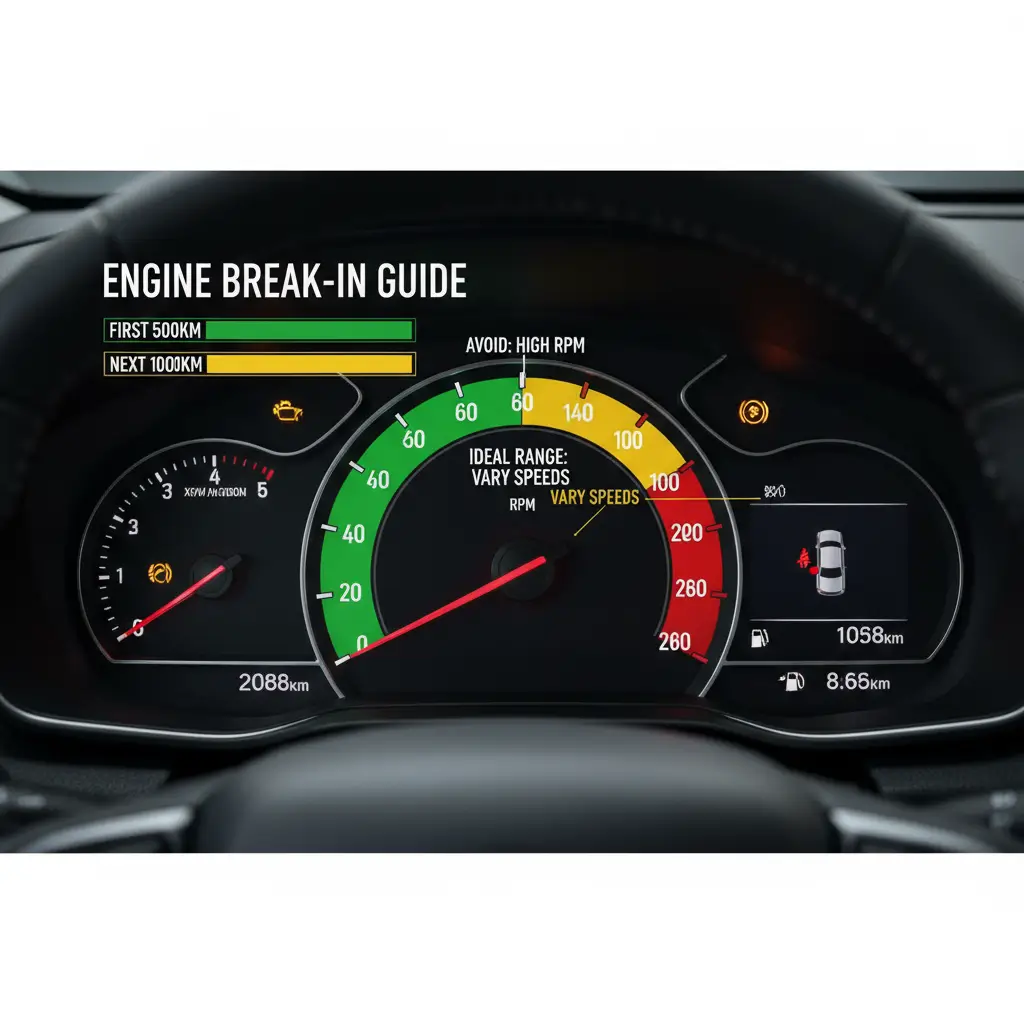
How Does an Engine Overhaul Work? Complete Guide to Engine Rebuilds
Key Takeaways
| Topic | Key Information | Important Details |
|---|---|---|
| Types of Overhauls | Top vs Full Overhaul | Top: cylinder head only; Full: complete engine rebuild |
| Warning Signs | 5 major indicators | Oil consumption, overheating, smoke, misfires, power loss |
| Process Steps | 5-stage procedure | Diagnosis, disassembly, inspection, rebuild, testing |
| Costs | R15,000-R65,000+ | Depends on engine type and extent of damage |
| Benefits | Extended lifespan | Improved performance, efficiency, and reliability |
Engine Overhaul Meaning
An engine overhaul is a comprehensive mechanical procedure that restores your vehicle’s engine to optimal working condition by repairing or replacing worn components. Understanding how this process works can help you make informed decisions about your vehicle’s maintenance and whether an overhaul is the right solution for your situation.
What is an Engine Overhaul?
An engine overhaul involves systematically disassembling your engine, inspecting all components for wear and damage, and rebuilding it with new or refurbished parts. The goal is to restore engine performance, efficiency, and reliability without the significant expense of purchasing a brand-new engine.
The fundamental principle of engine operation remains simple: fuel combustion creates controlled explosions in the combustion chamber, pushing pistons up and down to generate rotational power that ultimately turns your wheels. Over time, the components involved in this process experience wear, leading to decreased performance and potential failure.
Types of Engine Overhauls
Top Overhaul (Cylinder Head Overhaul)
A top overhaul focuses exclusively on the upper section of your engine, specifically the cylinder head. This procedure is performed while the engine block remains installed in the vehicle.
What’s Involved:
- Removal of cylinder head(s)
- Valve inspection and replacement
- Valve guide and seal replacement
- Cylinder head resurfacing
- Replacement of head gasket
- Timing component inspection
Typical Cost Range: R15,000 - R35,000
Best For:
- Valve-related issues
- Head gasket failures
- Compression problems isolated to cylinder head
- Overheating damage affecting head components
Full Engine Overhaul
A complete overhaul requires removing the entire engine from the vehicle and performing a comprehensive rebuild of both upper and lower engine components.
What’s Involved:
- Complete engine removal from vehicle
- Full disassembly of engine block and cylinder head
- Piston and piston ring replacement
- Crankshaft inspection and machining
- Main and rod bearing replacement
- Cylinder bore honing or reboring
- Complete gasket and seal replacement
- Timing system component replacement
Typical Cost Range: R35,000 - R65,000+
Best For:
- Extensive internal wear
- Bottom-end bearing problems
- Piston and cylinder wall damage
- Complete engine failure
- High-mileage engines requiring comprehensive restoration
Warning Signs You Need an Engine Overhaul
1. Excessive Oil Consumption
Symptoms:
- Frequent need to add engine oil between services
- Oil level dropping noticeably every few hundred kilometers
- Blue-grey smoke from exhaust during acceleration
- Oil spots under vehicle when parked
Causes:
- Worn piston rings allowing oil into combustion chamber
- Damaged valve stem seals
- Worn cylinder walls reducing sealing effectiveness
- Cracked piston causing oil bypass
What It Means: When piston rings or valve seals fail, engine oil leaks into the combustion chamber where it burns along with the fuel mixture, creating visible smoke and requiring constant oil top-ups.
2. Persistent Overheating
Symptoms:
- Temperature gauge consistently reading high
- White or grey smoke from exhaust
- Sweet smell from exhaust (coolant burning)
- Loss of coolant without visible external leaks
Causes:
- Blown head gasket allowing coolant into combustion chamber
- Cracked cylinder head permitting coolant leakage
- Warped head surface disrupting seal
- Internal coolant passage blockages
What It Means: Coolant entering the combustion chamber indicates a serious breach in engine sealing, typically requiring cylinder head work at minimum.
3. Excessive Exhaust Smoke
Smoke Color and Meaning:
- Blue-grey smoke: Burning engine oil (piston rings/valve seals)
- White/grey smoke: Burning coolant (head gasket/cracked head)
- Black smoke: Excessive fuel consumption (may indicate internal damage)
When to Worry: Smoke that persists throughout the day, not just during warm-up, indicates serious internal engine problems requiring professional diagnosis.
4. Engine Misfiring
Symptoms:
- Rough idle and vibration
- Hesitation during acceleration
- Check engine light illuminated
- Loss of power and poor fuel economy
Causes:
- Carbon buildup on spark plugs from oil burning
- Low compression due to worn piston rings
- Damaged or cracked pistons
- Valve sealing problems
What It Means: While misfires can result from ignition system issues, persistent misfires despite replacing spark plugs often indicate internal engine wear affecting compression.
5. Significant Power Loss
Symptoms:
- Noticeably reduced acceleration
- Difficulty maintaining highway speeds
- Engine struggles under load
- Poor throttle response
Causes:
- Worn intake/exhaust valves reducing airflow
- Low compression from piston ring wear
- Damaged cylinder walls affecting sealing
- Worn camshaft lobes reducing valve lift
What It Means: Progressive power loss typically indicates general internal wear across multiple engine components, suggesting a comprehensive overhaul may be necessary.
Critical Warning
If you experience multiple warning signs simultaneously, stop driving and seek professional diagnosis immediately. Continuing to operate an engine with serious internal problems can cause catastrophic failure, potentially increasing repair costs significantly. Learn more about common used engine problems to identify issues early.
The Engine Overhaul Process
Stage 1: Initial Diagnosis and Quote
Before any work begins, a qualified technician performs comprehensive diagnostic tests:
Diagnostic Procedures:
- Compression testing across all cylinders
- Leak-down testing to identify internal leaks
- Oil analysis for metal contamination
- Visual inspection via borescope when possible
- Computer diagnostics for sensor and system data
Initial Quote: Based on preliminary findings, you’ll receive a “strip and assess” quote covering the disassembly and detailed inspection phase. This typically ranges from R3,500 to R8,000 depending on engine complexity.
Stage 2: Engine Disassembly
Once approved, technicians systematically dismantle the engine:
 Professional tools required for a complete engine overhaul
Professional tools required for a complete engine overhaul
Top Overhaul Disassembly:
- Remove cylinder head(s)
- Extract valves, springs, and retainers
- Remove timing components (belt/chain)
- Clean all components for inspection
Full Overhaul Disassembly:
- Complete engine removal from vehicle (6-10 hours)
- Remove all external components (alternator, starter, etc.)
- Separate cylinder head from block
- Remove pistons, connecting rods, and crankshaft
- Clean all components thoroughly
Stage 3: Detailed Inspection and Final Quote
Every component undergoes meticulous inspection:
 Precision measurement is critical during engine inspection to determine component wear
Precision measurement is critical during engine inspection to determine component wear
Cylinder Head Inspection:
- Valve condition and sealing surfaces
- Valve guide wear measurement
- Head surface flatness verification
- Crack testing (magnetic particle or dye penetrant)
- Camshaft lobe wear assessment
Engine Block Inspection:
- Cylinder wall wear and scoring
- Crankshaft journal measurements
- Main bearing surface condition
- Block deck surface flatness
- Core plug condition
Final Quote: Based on inspection findings, you receive a detailed quote listing all parts requiring replacement and associated labor costs. This is when you learn the true extent of repairs needed.
Stage 4: Machining and Parts Replacement
Common Machining Operations:
- Cylinder head resurfacing: Milling head surface flat (R2,500-R4,500)
- Valve seat cutting: Ensuring proper valve sealing (R150-R300 per valve)
- Cylinder boring: Removing cylinder wall damage (R1,500-R3,000 per cylinder)
- Cylinder honing: Creating proper surface finish for piston rings (R800-R1,500)
- Crankshaft grinding: Restoring journal surfaces (R3,500-R6,000)
Parts Typically Replaced:
- Complete gasket set (R1,800-R5,000)
- Piston rings (R1,200-R3,500)
- Main and rod bearings (R2,000-R4,500)
- Timing belt/chain kit (R1,500-R8,000) - essential replacement for reliability (learn about BMW N47 timing chain problems as an example of timing chain failure)
- Oil pump (R1,800-R4,500)
- Water pump (R1,200-R3,500)
- Valve stem seals (R600-R1,500)
Stage 5: Reassembly and Testing
Reassembly Procedures:
- Install bearings with precise clearances
- Fit pistons with properly gapped rings
- Torque all fasteners to manufacturer specifications
- Install new gaskets and seals throughout
- Set valve clearances (if applicable)
- Install and time all components correctly
Quality Control Testing:
- Initial start-up procedure with careful monitoring
- Oil pressure verification
- Compression testing to confirm rebuild quality
- Leak testing for oil and coolant
- Road testing for performance verification
- Final adjustments and tuning
Time Required:
- Top overhaul: 8-15 hours labor
- Full overhaul: 25-40 hours labor
Professional Quality Assurance
Reputable workshops provide comprehensive testing after overhaul completion. This should include documented compression readings, oil pressure measurements, and a test drive to verify performance restoration.
Engine Overhaul Costs in South Africa
Cost Breakdown by Engine Type
| Engine Type | Top Overhaul | Full Overhaul | Replacement (New) |
|---|---|---|---|
| 4-Cylinder Petrol | R15,000 - R25,000 | R35,000 - R50,000 | R60,000 - R120,000 |
| 4-Cylinder Diesel | R18,000 - R30,000 | R40,000 - R60,000 | R70,000 - R150,000 |
| 6-Cylinder Petrol | R22,000 - R35,000 | R50,000 - R75,000 | R90,000 - R180,000 |
| V8 Petrol | R30,000 - R45,000 | R65,000 - R95,000 | R150,000 - R300,000+ |
Factors Affecting Overhaul Cost
Engine Complexity:
- Variable valve timing systems add R3,000-R8,000
- Turbocharger overhaul adds R8,000-R15,000 (see our guide on turbocharger problems and fixes)
- Dual overhead cam designs increase labor by 20-30%
Parts Quality:
- OEM (Original Equipment Manufacturer) parts: Highest cost, best quality
- OE (Original Equipment) quality aftermarket: 20-30% less than OEM
- Budget aftermarket parts: 40-50% less, variable quality
Labor Rates:
- Independent workshops: R350-R550 per hour
- Specialist performance shops: R550-R800 per hour
- Dealership service departments: R650-R950 per hour
Additional Repairs:
- Severely damaged components may require replacement rather than rebuilding
- Cylinder boring increases cost by R6,000-R12,000
- Crankshaft replacement adds R8,000-R25,000
Cost-Saving Considerations
While budget parts may seem attractive, using quality components ensures longevity. A properly rebuilt engine with OE-quality parts should last 150,000-250,000 km, making the investment worthwhile compared to repeated cheaper repairs.
Engine Overhaul vs. Engine Replacement
When to Choose Engine Overhaul
Advantages:
- Significantly lower cost than new engine purchase
- Retains original engine (important for some vehicles)
- Opportunity to upgrade certain components
- Known engine history and maintenance record
- Can address specific problem areas
Best For:
- Vehicles worth significantly more than repair cost
- Engines with sentimental or historical value
- When only specific engine sections need attention
- Well-maintained engines with isolated failures
When to Consider Engine Replacement
New Engine from Manufacturer:
- Cost: Often exceeds 50% of vehicle value
- Warranty: Comprehensive coverage (2-5 years typical)
- Reliability: Maximum peace of mind
- Best For: High-value vehicles, warranty requirements
Used/Second-Hand Engine:
- Cost: R8,000-R35,000 depending on engine type
- Warranty: Limited or none in many cases
- Risk: Unknown history, possible hidden problems
- Best For: Low-value vehicles not justifying overhaul cost
Remanufactured Exchange Engine:
- Cost: 30-40% less than new, similar to quality overhaul
- Warranty: 1-2 years typically
- Reliability: Professional rebuild with quality parts
- Best For: Balance of cost and reliability needs
Second-Hand Engine Risks
While used engines offer the lowest initial cost, the lack of warranty and unknown condition makes them risky. Hidden problems may not appear until after installation, potentially doubling your total expenditure.
Benefits of Engine Overhaul
Performance Improvements
Immediate Benefits:
- Restored power output matching original specifications
- Smooth, quiet operation eliminating unusual noises
- Improved throttle response and acceleration
- Elimination of vibrations and rough running
Long-Term Performance:
- Consistent power delivery across RPM range
- Better cold-start performance
- Reduced emissions and improved environmental compliance
Efficiency Gains
Fuel Economy:
- 10-25% improvement in fuel consumption typical
- Restored compression ensures complete combustion
- Elimination of oil burning reduces waste
- Proper valve sealing optimizes cylinder filling
Oil Consumption:
- Normal oil consumption between service intervals
- No need for constant top-ups
- Reduced emissions from burning oil
- Lower overall maintenance costs
Reliability and Longevity
Extended Engine Life:
- Properly overhauled engines last 150,000-250,000 km
- New components reduce breakdown risk
- Opportunity to address design weaknesses
- Fresh start with known maintenance history
Cost-Effective Longevity:
- Lower total cost than vehicle replacement
- Maintains vehicle’s overall condition and value
- Avoids depreciation hit of vehicle change
- Known maintenance history going forward
Environmental Benefits
Reduced Environmental Impact:
- Lower emissions from proper combustion
- Elimination of oil burning and smoking
- Reduced waste from keeping existing engine
- Better fuel efficiency reduces carbon footprint
Preventative Maintenance to Avoid Overhauls
Critical Maintenance Schedule
| Maintenance Item | Interval | Importance |
|---|---|---|
| Engine oil changes | Every 10,000-15,000 km | Critical - prevents wear |
| Oil filter replacement | Every oil change | Critical - maintains oil quality |
| Coolant system service | Every 40,000 km | High - prevents overheating |
| Timing belt replacement | Per manufacturer specs | Critical - prevents catastrophic damage |
| Air filter replacement | Every 15,000-20,000 km | Medium - ensures proper combustion |
| Spark plug replacement | Every 40,000-60,000 km | High - maintains efficient combustion |
Best Practices for Engine Longevity
Oil Maintenance:
- Use manufacturer-specified oil viscosity
- Never extend oil change intervals beyond recommendations
- Check oil level weekly
- Address any oil leaks promptly
- Use quality synthetic oils for severe driving conditions
Cooling System Care:
- Maintain proper coolant mixture (50/50 with distilled water)
- Replace coolant at recommended intervals
- Address overheating issues immediately
- Inspect hoses and clamps regularly
- Ensure radiator is clean and unobstructed
Driving Habits:
- Allow engine to warm up before heavy acceleration
- Avoid excessive idling which causes incomplete combustion
- Don’t lug the engine at low RPM under heavy load
- Avoid constant high-RPM operation
- Let turbocharged engines idle briefly before shutdown
Warning Sign Response:
- Investigate unusual noises immediately
- Address check engine lights promptly
- Don’t ignore small oil leaks
- Monitor coolant levels between services
- Pay attention to performance changes
Prevention is Cheaper Than Cure
Regular maintenance following manufacturer specifications typically costs R3,000-R6,000 annually. This preventative investment is far less expensive than a R35,000-R65,000 engine overhaul and dramatically extends engine lifespan.
Choosing the Right Workshop for Your Engine Overhaul
Essential Workshop Qualifications
Technical Expertise:
- Qualified automotive technicians with engine rebuild experience
- Access to proper machining equipment or partnerships with machine shops
- Experience with your specific engine type
- Up-to-date technical knowledge and training
Quality Standards:
- Use of OE-quality or OEM parts
- Proper torque specifications and procedures followed
- Comprehensive testing after completion
- Detailed documentation of work performed
Warranty Coverage:
- Minimum 1 year / 20,000 km warranty on labor and parts
- Clear warranty terms and exclusions
- Written warranty documentation
- Reputation for honoring warranty claims
Questions to Ask Potential Workshops
- What is included in your strip-and-assess quote?
- What brand of parts do you use for rebuilds?
- Do you perform the machining in-house or outsource it?
- What warranty do you provide on overhaul work?
- Can you provide references from previous engine overhaul customers?
- What testing procedures do you perform after completion?
- How long will the complete overhaul take?
- What is your payment structure (deposit, progress payments)?
Red Flags to Avoid
- Unwillingness to provide detailed written quotes
- Pressure to approve work without proper assessment
- Significantly lower prices than competitors (often indicates cheap parts)
- No warranty offered or very limited warranty terms
- Poor communication and vague explanations
- Lack of proper facilities or equipment
- No references or poor online reviews
After Your Engine Overhaul: Break-In Procedure
Critical Break-In Period
The first 1,500-3,000 km after an engine overhaul are crucial for long-term success.
 Follow proper RPM ranges during the critical break-in period to ensure optimal ring seating
Follow proper RPM ranges during the critical break-in period to ensure optimal ring seating
First 500 km:
- Vary engine speed constantly (avoid constant RPM)
- Avoid full-throttle acceleration
- No highway cruising at constant speed
- Keep RPM below 3,000 (petrol) or 2,500 (diesel)
- Change oil after first 500 km
500-1,500 km:
- Gradually increase RPM range
- Begin gentle highway driving
- Continue varying speeds
- Avoid heavy loads or towing
- No sustained high-speed driving
1,500-3,000 km:
- Progressively increase to normal operation
- Begin occasional full-throttle acceleration
- Resume towing and heavy loads gradually
- Change oil at 1,500 km
- Monitor closely for any issues
Break-In Do’s and Don’ts
DO:
- Vary engine speed and load frequently
- Monitor oil consumption and pressure closely
- Check coolant level regularly
- Listen for unusual noises
- Follow break-in oil change schedule strictly
DON’T:
- Use cruise control during break-in
- Tow heavy loads in first 1,500 km
- Perform repeated hard accelerations
- Allow prolonged idling
- Use synthetic oil until after first oil change
Why Break-In Matters
Proper break-in allows piston rings to seat correctly against cylinder walls, establishing the seal necessary for optimal compression and oil control. Rushing this process can result in permanently poor ring seating, reducing engine performance and increasing oil consumption.
Conclusion
An engine overhaul represents a significant investment, but when performed properly by qualified technicians using quality parts, it can restore your vehicle to like-new performance for a fraction of the cost of engine replacement. Understanding the process, recognizing warning signs early, and following proper maintenance procedures helps you make informed decisions about your vehicle’s care.
The key to successful engine longevity lies in preventative maintenance and addressing problems promptly before they escalate into major failures requiring comprehensive overhauls. Regular oil changes, cooling system maintenance, and attention to warning signs can extend engine life well beyond typical expectations.
Whether you’re currently facing engine problems or simply want to understand your options for the future, knowing how engine overhauls work empowers you to maintain your vehicle effectively and budget appropriately for its long-term care. For those needing replacement engines for sale rather than overhauls, Engine Finder offers access to quality used and reconditioned engines across South Africa to help you get back on the road.
FAQ
How long does an engine overhaul typically take?
A top overhaul typically requires 3-5 working days, while a complete engine overhaul takes 1-2 weeks depending on parts availability and any machining required. Complex engines or those requiring extensive machine work may take longer.
Can I drive my car if it needs an engine overhaul?
This depends on the specific problem. Minor oil consumption may allow continued driving with frequent oil top-ups, but serious issues like severe overheating, knocking noises, or loss of compression require immediate attention. Continuing to drive with major problems can cause catastrophic damage, significantly increasing repair costs.
How long will my engine last after an overhaul?
A properly performed engine overhaul using quality parts should provide 150,000-250,000 km of reliable service, similar to a new engine. Longevity depends on maintenance quality, driving conditions, and adherence to service intervals.
Is an engine overhaul worth it for an older vehicle?
Consider the vehicle’s overall condition and value. If the vehicle is well-maintained otherwise and worth more than R80,000-R100,000, an overhaul typically makes financial sense. For vehicles worth less than R50,000, a used engine or vehicle replacement may be more practical.
What warranty should I expect on an engine overhaul?
Reputable workshops typically provide 1 year / 20,000 km warranty on parts and labor. More extensive warranties (2 years / 40,000 km) may be offered by premium workshops. Always get warranty terms in writing before approving work.
Can I do an engine overhaul myself?
While experienced DIY mechanics can perform engine overhauls, specialized tools, precision measuring equipment, and machine work (boring, honing, grinding) require professional facilities. Most DIYers can handle removal and basic disassembly but should use professional machine shops for precision work.
What’s the difference between an engine overhaul and engine rebuild?
These terms are often used interchangeably, both referring to comprehensive engine restoration. “Overhaul” sometimes implies addressing specific problems, while “rebuild” suggests complete disassembly and restoration, but in practice, workshops use the terms synonymously.
Will my fuel economy improve after an engine overhaul?
Yes, typically by 10-25% compared to the worn engine. Restored compression, proper ring sealing, and correct valve timing ensure optimal combustion efficiency. However, fuel economy should return to approximately what the engine achieved when new, not exceed it.
References and Sources
This article is based on industry-standard automotive repair practices and technical information from authoritative sources:
1. WikiHow - Engine Rebuild Guide
Comprehensive step-by-step engine rebuild procedures
https://www.wikihow.com/Rebuild-an-Engine
Expert-reviewed instructions for DIY mechanics
2. Stonum Automotive - Engine Overhaul Guide
Detailed explanation of engine overhaul process and costs
https://stonumautomotive.com/what-is-an-engine-overhaul-a-comprehensive-guide-to-definition-process-and-cost/
Practical insights for vehicle owners
3. Wikipedia - Engine Tuning (Overhaul)
Technical overview of engine overhaul procedures
https://en.wikipedia.org/wiki/Engine_tuning#Overhaul
General reference for automotive maintenance concepts
Disclaimer
While this article draws from authoritative industry sources and established automotive repair practices, specific procedures, costs, and recommendations may vary based on vehicle make, model, engine type, and regional factors. Always consult with qualified automotive technicians and refer to manufacturer-specific service documentation for your particular vehicle. Cost estimates are approximate and based on South African market conditions as of 2025.
For technical repairs and engine work, always engage certified professionals with appropriate training, equipment, and insurance. Engine Finder is not responsible for repairs performed based on this informational guide.
Important Disclaimer
This content is for informational purposes only and is based on research from automotive industry sources. Engine Finder is not a certified automotive repair facility. Always consult with qualified automotive professionals before performing any repairs or maintenance. Improper repairs can result in personal injury, property damage, or vehicle malfunction. We assume no responsibility for actions taken based on this information.
